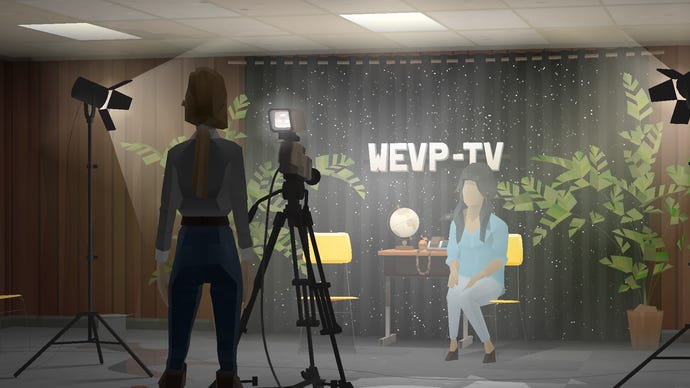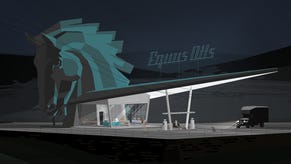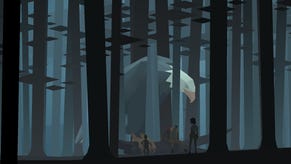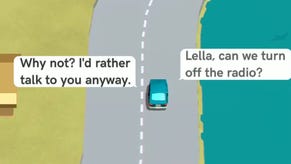Kentucky Route Zero Primer: What You Should Know Ahead of the Acclaimed Indie's Final Act
There's a lot of buzz about the finale of Kentucky Route Zero. Here's why you should be paying attention.
This article first appeared on USgamer, a partner publication of VG247. Some content, such as this article, has been migrated to VG247 for posterity after USgamer's closure - but it has not been edited or further vetted by the VG247 team.
Yesterday, developer Cardboard Computer revealed that Kentucky Route Zero, the episodic adventure game that properly kicked off in 2013, is finally coming to a close at the end of this month. It's a huge revelation, considering it was funded on Kickstarter way back in 2011, released its first two "Acts" in 2013, and ever since, has released episodes at a slow rate. But Jan. 28 will see the end of Kentucky Route Zero.
Despite the slow pace of development, the episodic adventure game has never quite stood still. Between episodes, the three person development team of Ben Babbitt, Jake Elliott, and Tamas Kemenczy has released "interludes," micro Acts that usually have some stylish mechanical conceit. They're vignettes centered around other characters you meet along the roads of Kentucky.
In The Entertainment, for instance, you watch a "play" by Bureau of Reclaimed Spaces clerk Lula Chamberlain. Your perspective is rooted in the center of The Lower Depths bar, as you spin around to see both an audience behind you, and a stage play unfolding in front. You can even play it in VR. You watch and listen to the patrons talk about their debt, dead end jobs, and the local whiskey distillery that has a way of claiming their souls basically in exchange for debt. Everyone is victim to crippling debt in one way or another.

Amidst all the American realities like homelessness and debt are fantastical elements. The Zero is a secret highway that lies underneath Kentucky. The Bureau of Reclaimed Spaces is an organization that studies and lies within the Zero—think like the Bureau of Control in Remedy's Control. The Mucky Mammoth is a ship with a giant mechanical mammoth at the helm. Hard Times is an underground whiskey distillery operated by neon-glowing skeletons that allows people to trade in their debts to work there for presumed eternity. Scenes in Acts swerve into the surreal, but oddly, nothing ever feels out of place. Everything gels perfectly.
What is Kentucky Route Zero?
In the early-to-mid 2010s, Kentucky Route Zero dominated the critical conversation. Heavily influenced by the fallout of the Great Recession, Kentucky Route Zero is a game about the people most affected by economic collapse. It follows a band of characters who find themselves affected by rough economic circumstance in all sorts of ways.
You begin as Conway, an antique delivery man with a mangy dog companion. Conway has one last delivery to make before his boss closes up shop for good. After all, she's widowed, he's a recovering alcoholic, and they're both getting old. The address he has to deliver to is strange though: It's on a street that does not exist. Early on, a man named Joseph at a gas station shaped like a horse tells him that he has to find "the Zero," a secret underground highway that runs through all of the state of Kentucky.
From there, you start to form a "party" of sorts. There's Shannon, a TV repairwoman with an affinity for ghosts who we find exploring the mines where her parents died in a flood. There's Ezra, a boy who calls a giant eagle named Julian his brother, who was abandoned after his parents were evicted from their home. And then there's everyone else: the robot musicians who ride on motorcycles from venue to venue with no roof over their head, the captain of The Mucky Mammoth, and so on. The common thread of everyone that joins Conway in his travels? No one, like him, really has a home. They make their own nomadic home with their found family.
The journey to find 5 Dogwood Drive is anything but neat. The address is a long ways away, and most people don't even know its existence. It's a road that exists with no streets connecting to it, making it a complicated place to find—even on an extra dimensional plane like The Zero. All along the road trip, Conway and co. drive and sail from location to location, meeting others who also find themselves on hard times. Some join them on their journey, most don't.

It's a point-and-click adventure in the most basic sense of the genre. You pick dialogue choices, which rather than impact the story in dramatic ways, subtly shift your own journey through it. You can choose a certain character's perspective, or choose what you want Conway's dog's name to be. In between, you drive or sail to different locations. Sometimes you happen upon strange scenes—like a gathering of old men pushing a rundown plane that doesn't look like it can fly—other times you follow directions to a T to move the story along.
There are moments that break away from this basic structure. Act 3 bears a memorable text adventure detour that functions as an ode to the pioneers of the genre. Act 4 is narrated as if this were a story witnessed long, long ago. There's something about the dialogue in Kentucky Route Zero that's always been really special: It feels natural and vulnerable. It's concise, and never stuffed with exposition. The folks of Kentucky Route Zero feel like real people who have gone through real turmoil. Rather than wallow, they accept it.
Kentucky Route Zero, more than any other game this decade, is a game about America—like, real America. It's a deconstruction of the "American Dream," where just staying afloat. Where people find themselves evicted, laid off, in debt. It's a game about how Americans persist in spite of all that, no matter the cost. Its bleakness never gets in the way of the magical realism at the heart of it either. If anything, it all accentuates it. Before replaying the first four Acts recently, I only remembered Kentucky Route Zero in snippets. But those snippets have stuck out in my mind possibly more than any other adventure game, ever.
What We've Written About Kentucky Route Zero
USgamer started as a site in 2013, the very same year that Kentucky Route Zero debuted. In our early days, independently developed games were very much a blindspot. In looking through our backlog, we only even mention Kentucky Route Zero a handful of times. In 2016, contributor Jeremy Signor explored the conversational nature of Act 4, which released the same year. Signor wrote how it's best at letting "you explore the contours of conversation as a vital lifeline of human connection." In 2017, I wrote a list about my favorite cafes and bars in video games, and zeroed in on the Hard Times whiskey-serving The Lower Depths. Bafflingly, I don't even mention Junebug and Johnny's performance there. What was I thinking? (I think I was only thinking about the aforementioned interlude.)
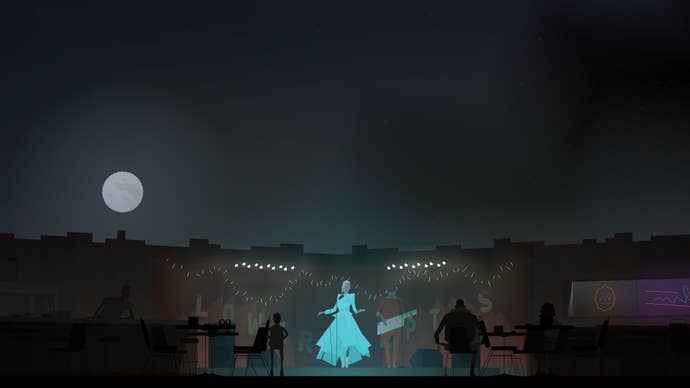
Why Kentucky Route Zero Matters
Even though it's been three-and-a-half years since Act 4 released in July 2016, fans have been just as excited for Act 5 of Kentucky Route Zero as they've ever been. It's why when the Kentucky Route Zero hotline changed its status late last week, Twitter erupted in excitement. A countdown to Jan. 6 for 9 a.m. PT kicked off, causing fans to believe Act 5 would finally be launching. They were close: It was the time its release date was officially unveiled. Supporters have also been helping fund Kentucky Route Zero's further development through Patreon since Cardboard Computer launched it in 2018.
There aren't many games that have elicited Kentucky Route Zero's amount of buzz and critical adoration, and maintained it, for literally a decade. Kentucky Route Zero, in that sense, is an anomaly. It's an anomaly for good reason though. Even in its "unfinished state," it landed on both IGN's and Polygon's best games of the decade list for the 2010s. It's landed on more than few Game of the Year lists each year an Act has released. It's the episodic game that defies the unspoken "you can't really judge a game by just one part" rule; every part can be judged, and it's all magnificent.
In her review of Act 4, Astrid Budgor wrote in the now-defunct Kill Screen about the technical confidence in how scenes are framed and written in Act 4. It's a level of polish not seen before in the series. "A later scene where Ezra and the boat's captain Cate pick mushrooms on a small underground island of cypress trees experiments with pairing a long shot and dual strands of prose—they both describe the characters' actions and relay hazy memories," she wrote. "That the appearance of a derelict Civil War ship called the Iron Pariah, full of wailing cats, drifting huge and silhouetted past the camera feels not like an intrusion but the scene's natural emotional peak is proof enough that Cardboard Computer really f**king know what they're doing."
Kentucky Route Zero is also a game that's often experimented with mediums beyond just video games. Game developer Robert Yang blogged about the transmedia approach to its latest interlude Un Pueblo De Nada (The People of Nothing) in 2018, which weaves a hotline you can actually call, a public access documentary, and a short video game into one tragic experience. (Caution: spoilers for the interlude abound.)
In analyzing the dialogue for Rock Paper Shotgun pre-Act 4's release in 2016, Alex Wiltshire wrote of the "subtle dynamism" of its choice-driven dialogue options. "[T]he choices you're given are still meaningful. Perhaps we're also directors of this story, because I have my own Conway. He's a gentle and uncomplicated man; he speaks as he sees, and doesn't see very much. But he could be more insightful or more assertive if I chose other options. You know they won't really shift the narrative but they have a knack of letting the characters breathe, and you get a greater idea of who they are, and who they could be."
The curative blog aggregator Critical Distance compiled a compilation of long reads on Kentucky Route Zero as well. If you'd like to read more analyzing the midwest-set adventure, I suggest checking it out.
If you haven't played through Acts 1 through 4 and all the interludes in between, that's fine. Originally, I played sporadically for nearly all of my adult life at this point. Now, I've revisited all the acts and interludes ahead of Act 5's imminent release. It's just as, if not more, impactful today. I don't think the meaning of it will be lost by binging it all in one go either. Kentucky Route Zero won't just be crossing the finish line on PC on Jan. 28, it'll be coming to consoles too with a complete TV Edition. Stay tuned for later this month for a full review of Kentucky Route Zero, and more content.
